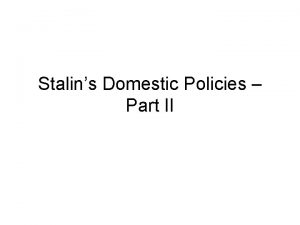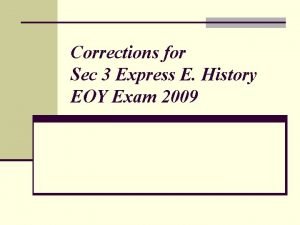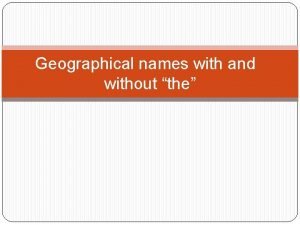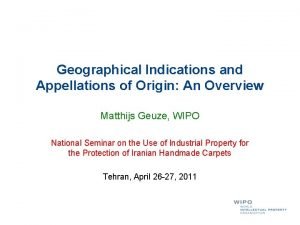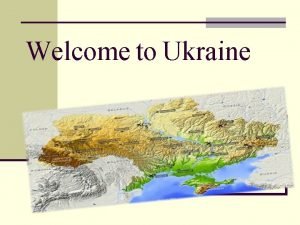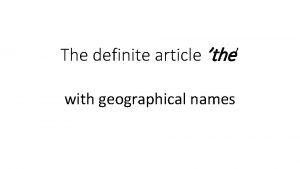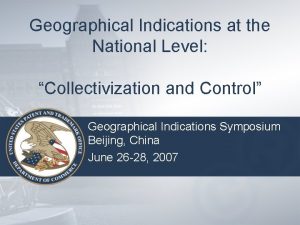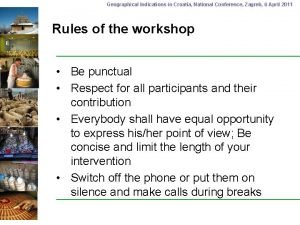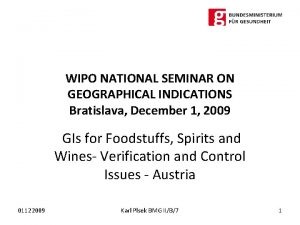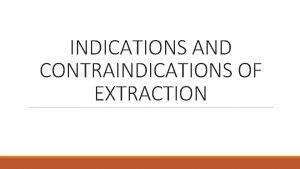Geographical Indications at the National Level Collectivization and















- Slides: 15

Geographical Indications at the National Level: “Collectivization and Control” Geographical Indications Symposium Beijing, China June 26 -28, 2007

Why Do GIs Matter to Us? • Higher prices for producers • Higher quality for consumers • Promotes efficiencies in the marketplace by minimizing search costs for consumers. FRANCE INDIA “Roquefort” for cheese U. S. Reg. No. 571, 798 “Darjeeling” and Design for tea 12/4/2020 U. S. Reg. No. 2, 685, 923 SWITZERLAND “Swiss” for chocolate U. S. Reg. No. 1, 570, 455 2

So How Do We Achieve that? Preserve customer expectation for the goods via: Black Rooster design for wine U. S Reg. No. 1860163 Italy • Collectivization • Control “Brunello di Montalcino” for wine U. S. Reg. No. 1860163 Italy “Frankfurter Äpfelwein” for wine U. S. Reg. No. 1097779 Germany 12/4/2020 3

GIs are Private Property Rights • Geographic place names are just place names and not intellectual property rights. • GIs are IP rights because they can indicate: – Origin + – Producers + – Characteristics + – Production methods + – “Je ne sais quoi” Consumers buy goods with GIs on them because the GIs represent material information used in the purchasing decision. “Parma” and design for ham U. S. Reg. No. 2014627 - Italy “Parmigiano-Reggiano” for cheese - U. S. Reg. No. 1754410 - Italy “Vino Nobile di Montepulciano” for wine - U. S. Reg. No. 2251165 - Italy 12/4/2020 4

Imprinting GIs must provide shorthand communicative signals in order to influence consumers’ purchasing decisions. How do we imprint GIs with this information? v By controlling the use of the geographic terms by those producers meeting certain quality or production standards for specific goods. How do we control the use of geographic terms? v Collectivize the producers. “COGNAC” common-law certification mark for brandy - Institut National Des Appellations v. Brown-Forman Corp, 47 USPQ 2 d 1875, (TTAB 1998) - France 12/4/2020 5

Market Forces Encourage Collectivization and Control • Collectivization = allows producers to join together for the purpose of selling their goods efficiently at a premium price. • Control = ensures consistent quality or production standards for the goods. • Consistent quality and control preserve consumer expectations. • If appropriately commercialized and promoted, the controlled use of GIs by collective producers can lead to increased consumer demand for niche products and can lead to the ability to charge premium prices. design for raisins from California - U. S. Trademark Reg. No. 1527146 - US 12/4/2020 “The Florida Sunshine Tree” for citrus - U. S. Reg. No. 1559414 - US 6

TMs and Collective Marks: Collectivization Leads to Control Trademarks and Collective Marks: Acquired distinctiveness required for geographic terms. Delayed grant of exclusivity – only to those who have exclusively and continuously used the geographic term as a source identifier. Rewards producers and collectives who have already commercialized a geographic term as a source identifier. Collectives or cooperatives are usually the owner – already collectivized and subsequently control the use of the term by their members. “Solingen” for cutlery U. S. Reg. No. 0987576 Germany 12/4/2020 7

Certification Marks: Control Can Lead to Collectivization • Certification marks: no acquired distinctiveness required for geographic terms. • Owner is usually a governmental body or association of producers working on behalf of producers in a geographic region. • Certifier certifies conforming goods. • Certifier may not discriminately refuse to certify goods that meet the standards. • Latecomers to the collective group of users are allowed entrance – no discrimination. Juan Valdez design for “California” and design for strawberries - U. S. Reg. No. 2448047 - US 12/4/2020 coffee - U. S. Reg. No. 1266492 & “Colombia” for coffee - U. S. Reg. No. 1130792 Colombia 8

Collectivization and Control Create Value for the GI and for Consumers • Market forces incentivize producers in a region to collectivize in order to benefit from the controlled use of a distinctive term, rather than having all use it in a noncontrolled and potentially non-meaningful manner. • Value (via higher prices) created when the GI is meaningful to consumers by virtue of the information conveyed beyond mere origin of the goods, i. e. , quality or characteristics. • The value of the GI grows as the link between the place, the goods, the producers, and the quality gets stronger and more meaningful to consumers in that territory. • Moreover, controlled use prevents terms from sliding into genericism. “Comté” for cheese - U. S. Reg. No. 1473687 France 12/4/2020 “Jamaica Blue Mountain” for coffee - U. S. Reg. No. 1414598 Jamaica 9

Descriptive Uses Defeat Distinctiveness Claim • Unauthorized prior uses of a geographic term in a trademark-like manner will defeat a later claim to distinctiveness for that geographic term and defeat a claim of exclusivity. • Using USPTO registration system as an example: – For trademarks and collective marks, prior unauthorized third party registrations for marks comprising or consisting of a geographic term (even with geographic terms disclaimed) block a later application to register the mark because those registrations uses show that the term is geographically descriptive for the goods and therefore non-distinctive. – For certification marks, prior unauthorized registrations for marks comprising or consisting of a geographic term (even with geographic terms disclaimed) block an application to register because those registrations are evidence of lack of control over the use of the term by the certifier and thus, a lack of distinctiveness. 12/4/2020 10

Trademarks and GIs are Private Property Rights • Under the United States Constitution, the USG may not “take” private property rights away from citizens without compensation. That means that we cannot cancel ex officio, or impinge on, the rights of validly granted prior trademark owners based on a later filed GI application, either foreign or domestic. • A prior trademark registration consisting of or comprising a geographic term, even disclaimed, can block a later filed certification mark or collective mark application. USPTO cannot issue a registration over the existing prior trademark registration. Such an action would negatively impact the rights of the earlier holder without compensation. “Napa Valley” and design for wine - U. S. Reg. No. 2853642 - US 12/4/2020 11

Example Trademark Registration for “David’s Springfield Cookies” with disclaimer of “Springfield cookies” (geographically descriptive for cookies from Springfield, USA). Assume validly granted trademark. – Certification mark application filed by Steve for “Springfield” for cookies made 100% in Springfield according to certain production method standards. – Steve’s certification mark application is refused - not exercising legitimate control over the mark. – If David is actually affiliated (or wishes to be) with the certification mark applicant and meets the standards already (or wishes to for purposes of increasing the value of his trademark), Steve can ask David for consent to register the certification mark and submit that consent to the USPTO will evaluate whether consent will be sufficient to allow registration of the certification mark application. • However, if David does not meet the production standards contained in the certification mark – and does not wish to – the USPTO may not issue the certification mark registration over David’s prior trademark: – Certification mark indicates control. If certifier isn’t controlling all uses, then the certification mark isn’t valid. – Prior trademark registrant could face enforcement action by the later in time certifier to force him to meet the standards – diminishes the value of his prior valid rights. – Consumers would get two sets of inconsistent signals by virtue of the two differing uses of the same sign. – No one wins in the end as neither mark has much significance to consumers anymore and demand for both products decrease. • The US does not allow coexistence without consent for these reasons. • NOTE: If the trademark was actually registered contrary to U. S. law, then it is up to an interested third party to raise that issue in a cancellation proceeding at the USPTO or at federal court. 12/4/2020 12

Who Controls Whom? • International debate is about who should control the use of geographic terms: – Owners? – Governments? Remember: owners can be governments – as private right holders. “Vidalia” for onions U. S. Reg. No. 1709019 US 12/4/2020 “Idaho” for potatoes U. S. Reg. No. 2914308 US 13

Collectivize and Get Consent Examples: v Government of Ethiopia Licensing Initiative for specialty coffees v Colombian Coffee Federation Licensing Program for Juan Valdez Logo v Idaho Potato Commission Licensing Program v Florida Citrus Department Licensing Program v Vidalia Onion Licensing Program 12/4/2020 14

May the best cheese win. • Governmental control and regulation of GIs as public rights with public funds is a policy choice, not an international mandate. • There are other options that serve owners, consumers, and producers just as well, if not better, and which do not require public funds to subsidize private property rights. • Market forces encourage collaboration and collectivization for the benefit of all. • Let the market decide. 12/4/2020 15
 Define collectivization
Define collectivization Chinese communist revolution ap world history
Chinese communist revolution ap world history Collectivization
Collectivization Stalins five year plans
Stalins five year plans Collectivization
Collectivization Collectivization
Collectivization Continents without names
Continents without names Indications and appellations of origin
Indications and appellations of origin Geographical names with and without the
Geographical names with and without the Geographical position of ukraine
Geographical position of ukraine Evolution
Evolution Registration process of geographical indication
Registration process of geographical indication Registration of geographical indication
Registration of geographical indication Products of the southeast region
Products of the southeast region Coastline paradox
Coastline paradox The with geographical names
The with geographical names


